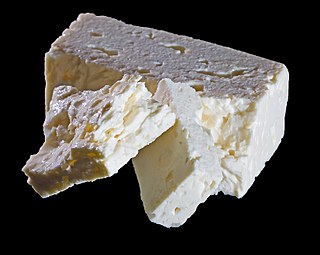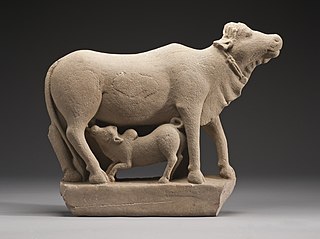
Cheddar cheese is a natural cheese that is relatively hard, off-white, and sometimes sharp-tasting. It originates from the English village of Cheddar in Somerset, South West England.

Mozzarella is a semi-soft non-aged cheese prepared using the pasta filata ('stretched-curd') method with origins from southern Italy.

Feta is a Greek brined white cheese made from sheep milk or from a mixture of sheep and goat milk. It is soft, with small or no holes, and no skin. Crumbly with a slightly grainy texture, it is formed into large blocks and aged in brine. Its flavor is tangy and salty, ranging from mild to sharp. Feta is used as a table cheese, in salads such as Greek salad, and in pastries, notably the phyllo-based Greek dishes spanakopita "spinach pie" and tyropita "cheese pie". It is often served with olive oil or olives, and sprinkled with aromatic herbs such as oregano. It can also be served cooked, as part of a sandwich, in omelettes, and many other dishes.

Caerphilly is a hard, crumbly white cheese that originated in the area around the town of Caerphilly, Wales. It is thought to have been created to provide food for the local coal miners. The Caerphilly of that period had a greater moisture content, and was made in local farms. At the start of the 20th century, competition for milk in the local area saw production decline, and Caerphilly production was gradually relocated to England.

Goat cheese, goat's cheese or chèvre is cheese made from goat's milk. Goats were among the first animals to be domesticated for producing food. Goat cheese is made around the world with a variety of recipes, giving many different styles of cheeses, from fresh and soft to aged and hard.

Ricotta is an Italian whey cheese made from sheep, cow, goat, or Italian water buffalo milk whey left over from the production of other cheeses. Like other whey cheeses, it is made by coagulating the proteins that remain after the casein has been used to make cheese, notably albumin and globulin.

Cheesemaking is the craft of making cheese. The production of cheese, like many other food preservation processes, allows the nutritional and economic value of a food material, in this case milk, to be preserved in concentrated form. Cheesemaking allows the production of the cheese with diverse flavors and consistencies.

Burrata is an Italian cow's milk cheese made from mozzarella and cream. The outer casing is solid cheese, while the inside contains stracciatella and clotted cream, giving it an unusual, soft texture. It is a speciality of the Puglia region of southern Italy.
Artisanal cheese refers to cheeses produced by hand using the traditional craftsmanship of skilled cheesemakers. As a result, the cheeses are often more complex in taste and variety. Many are aged and ripened to achieve certain aesthetics. This contrasts with the more mild flavors of mass-produced cheeses produced in large-scale operations, often shipped and sold right away.
Valley Shepherd Creamery is an artisan cheese making farm in Long Valley, New Jersey, and the winner of Edible Communities' New Jersey Food Artisan award in 2009.
Winchester Cheese Company was an artisan cheese producer in the town of Winchester, California in Riverside County, Southern California.

Egyptian cheese has a long history, and continues to be an important part of the Egyptian diet. There is evidence of cheese-making over 5,000 years ago in the time of the First Dynasty of Egypt. In the Middle Ages, the city of Damietta was famous for its soft, white cheese. Cheese was also imported, and the common hard yellow cheese, rumi, takes its name from the Arabic word for "Roman". Although many rural people still make their own cheese, notably the fermented mish, mass-produced cheeses are becoming more common. Cheese is often served with breakfast, and is included in several traditional dishes, and even in some desserts.

Swiss-type cheeses, also known as Alpine cheeses, are a group of hard or semi-hard cheeses with a distinct character, whose origins lie in the Alps of Europe, although they are now eaten and imitated in most cheesemaking parts of the world. Their distinct character arose from the requirements of cheese made in the summer on high Alpine grasslands, and then transported with the cows down to the valleys in the winter, in the historic culture of Alpine transhumance. Traditionally the cheeses were made in large rounds or "wheels" with a hard rind, and were robust enough for both keeping and transporting.

Çökelek is a fermented and acid/heat coagulated fresh cheese from Turkey and Azerbaijan. It can be produced from heating fermented buttermaking by-products such as buttermilk (yayıkaltı), though skimmed milk yogurt can also be used as a starting material. It can also be obtained from yayık ayranı through heat exposure. Despite its similar appearance, it is distinct from Lor, a form of curdled whey product similar to cottage cheese. Keş, şor, ekşimik and minci are different local names associated with çökelek.

Dairy plays a significant part in numerous aspects of Indian society, including cuisine, religion, culture, and the economy.
Killeen Farmhouse Cheese is a small farmhouse cheese maker based from a farm on the banks of the river Shannon near Portumna County Galway, Ireland.












